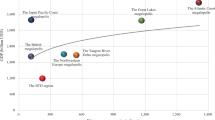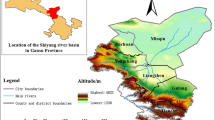Abstract
On the basis of studies on water and land resources affecting urban development and urban system structure in Xinjiang, this paper analyzes the utilization status and shortage of urban water resources. It is considered that both the consumption and waste of urban water resources are in an increase trend. Most cities and towns in Xinjiang are in shortage of water resources, however, waste of water resources are serious, especially in small towns. The development of the megapolis and moderate cities is evidently restricted by limited land resources. Though there are relatively large spaces of expanding the small cities and towns, the output benefits of water and land resources are low. In order to achieve the ordinal expansion of urban system structure in Xinjiang, it is suggested to take the urban spatial development pattern of “one circle and three belts” and the resources-economized strategy in the rapid development of urbanization.
Similar content being viewed by others
References
Fang C, Li M. Urbanization mode with the restriction of water resources in Hexi Corridor, an arid area of northwest China. Geographical Research (in Chinese), 2004, 23(6): 825–832
Fang C, Bao C, Sheng Y. Analysis on the characteristics and the change trend of urban expansion restricted by water resources in the arid areas of northwest China. J Natural Resources (in Chinese), 2004, 19(2): 248–256
Fang C, Bu W. Competitiveness and extent of regional expansion restricted by water resources of Hexi Corridor. Scientia Geography Sinica (in Chinese), 2004, 24(5): 515–521
Bureau of Statistics of Xinjiang Uygur Autonomous Region. Xinjiang Statistical Yearbook-2003 (in Chinese). Beijing: China Statistics Press, 2004. 1
Xie X. Economic Geography of Xinjiang (in Chinese). Beijing: Xinhua Press, 1991. 12
Li Z. The earth’s surface structure and urban system of arid land. J Gansu Sciences (in Chinese), 1999, 11(1): 78–82
Han D. Artificial Oases in Xinjiang (in Chinese). Beijing: China Environmental Science Press, 2001. 32, 26, 64
Zhang X. Influence of desert mineral resources exploitation on the spatial structure of the urban system in Xinjiang. Sci China Ser D-Earth Sci, 2002, 45(Suppl.): 180–184
Wang S. Current oases and their development tendency in the arid areas of China. In: Collection in Geographical Symposium of Arid Land (in Chinese). Beijing: Science Press, 1991. 39–43
Fan Z, Mu G, Ma Y, et al. Formation and development of the artificially irrigated oases in the northern piedmont of the Tianshan Mountains. Scientia Geography Sinica (in Chinese), 2002, 22(4): 184–189
Chen W, Zhou C, Li J. Economic development and oasis growth at the northern foot of the Tianshan Mountains. Acta Geographica Sinica (in Chinese), 2002, 57(5): 561–568
Chen B. Tianshan Mountains north slope economic development belt of Xinjiang, China. China Soft Science (in Chinese), 2002, (3): 92–95
Song Y, Fan Z. Study on the Water Resources and Economic Environment in the Tarim River Watershed (in Chinese). Urumqi: Xinjiang People’s Press, 2000. 198
Jia S. Analysis on the conditions of zero increase of industrial water consumption: Experience of developed countries. Progress in Geography (in Chinese), 2001, 20(1): 292–295
Liu C, Chen Z. Evaluation on the Actuality of Water Resources and Analyses on the Trend of Supply and Demand (in Chinese). Beijing: China Water Conservancy and Hydropower Press, 2000. 133
Wu X. Tread and management groundwater resources in Xinjiang. Arid Environment Monitoring (in Chinese), 2001, 15(2): 79–81
Qiu Y, Liu F. Water resources and its transform model of Urumqi River Watershed. Advances in Water Science (in Chinese), 1999, 2(4): 244–250
Tian G, Liu J, Zhuang D. The temporal-spatial characteristics of rural residential land in China in the 1990s. Acta Geographica Sinica (in Chinese), 2003, 58(5): 651–658.
Lei J, Zhang X, Wu S, et al. Study on the temporal-spatial characteristics of the rural-urban construction land use change in Xinjiang. Scientia Geography Sinica (in Chinese), 2005, 25(2): 160–166
Gao P. A Comparative Study on Urbanization of China with That in Foreign Countries (in Chinese). Tianjin: Nakai University Press, 1991, 177
Du H, Zhang X. A study on urban spatial agglomeration in Xinjiang in recent years. Scientia Geography Sinica (in Chinese), 2005, 25(3): 268–273
Lei J, Lu Q, Zhang J, et al. The development of small towns and rural urbanization in Xinjiang in recent years. China Population Resources and Environment (in Chinese), 2004, 71(4): 85–90
Fang C, Huang J, Bu W. Theoretical study on urbanization process and ecological effect with the restriction of water resources in arid areas of northwest China. Arid Land Geography (in Chinese), 2004, 27(1): 1–7
Author information
Authors and Affiliations
Corresponding author
About this article
Cite this article
Zhang, X., Lei, J. Trend of urban system structure under the restriction of water and land resources in Xinjiang. CHINESE SCI BULL 51 (Suppl 1), 179–188 (2006). https://doi.org/10.1007/s11434-006-8224-x
Received:
Accepted:
Issue Date:
DOI: https://doi.org/10.1007/s11434-006-8224-x




